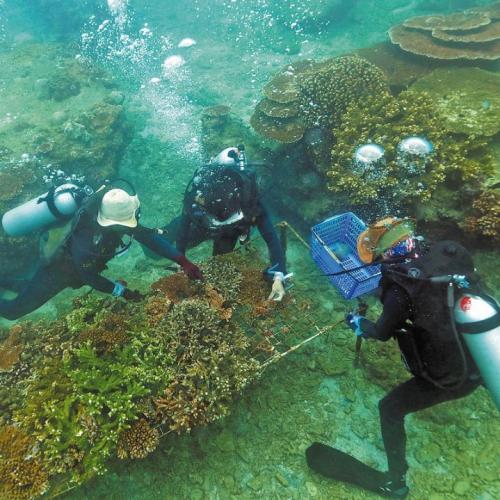



On the evening of May 30, as the tide receded in Sanya Bay in Sanya, Hainan province, diverse forms of coral reefs were seen flourishing in the clear waters of an experimental base. This base was set up for coral restoration at the South China Sea Institute of Oceanology, Chinese Academy of Sciences.
It is a corner of the "underwater rainforest" that Chen Hong, director of the institute, and his team have dedicated themselves to cultivating for many years.

Chen, one of the pioneers in coral gardening in Hainan, has devoted himself to the underwater "coral planting" initiative for over three decades. His dream was to create a vibrant and colorful "underwater rainforest" surrounding the waters of Hainan Island. Despite numerous challenges and dangers faced during his countless dives into the ocean to plant corals, he never gave up.
Coral reefs are among the most biodiverse ecosystems on Earth, often referred to as the "tropical rainforests of the ocean". They play a crucial role in maintaining biodiversity, stabilizing coastlines and promoting carbon cycling. Coral reefs growing along the country's coast can also support the country's "dual-carbon" strategy and defend its marine rights.

However, coral reefs have been declining globally due to climate change, outbreaks of harmful organisms, and human activities.
Hainan is a significant area for coral reef distribution in China. In recent years, the province has been steadfast in scientifically protecting and restoring coral reef ecosystems, continuously enhancing the diversity, stability and sustainability of marine ecosystems.
Today, Chen has moved beyond the solitary struggle. More and more research teams and environmental protection forces in Hainan are forming a united front to safeguard the "underwater rainforest".

On June 3, in a laboratory at Hainan University, the research team led by coral reef ecology expert Li Xiubao was engrossed in studying innovative approaches to coral reef ecological restoration.
Over the years, members of the team have explored the waters surrounding Hainan Island and the Nansha and Xisha islands, witnessing the rapid development of coral protection and restoration efforts in Hainan.

Professional divers serving as voluntary coral reef conservationists in places like Wuzhizhou Island and Fenjiezhou Island routinely carry out underwater "forest protection" work. The special "coral guardians" traverse the colorful seabed year-round, diligently safeguarding the marine creatures' habitats.
With the use of drones, underwater robots and other technologies in coral reef protection and restoration, scientific advancements are injecting new vitality into this "tropical rainforest" of the ocean.

Wang Aimin, a retired professor of marine biology at Hainan University and now chief scientist at the Hainan International Blue Carbon Research Center, and his team utilize underwater robots to monitor coral health conditions closely. They plan to use satellite remote sensing to track coral reef areas and monitor their health conditions on a large scale.

For years, Hainan has upheld ecological principles, placing coral reef ecological protection and restoration at the forefront and implementing various measures to transform the protection and restoration of coral reef ecosystems into a flagship project for building a national ecological civilization experimental zone in Hainan.
As people's awareness of marine conservation continues to grow, more "underwater coral planters" are using their wisdom and hard work to lay a solid ecological foundation for the sustainable future of our "blue homeland".
If you have any problems with this article, please contact us at app@chinadaily.com.cn and we'll immediately get back to you.